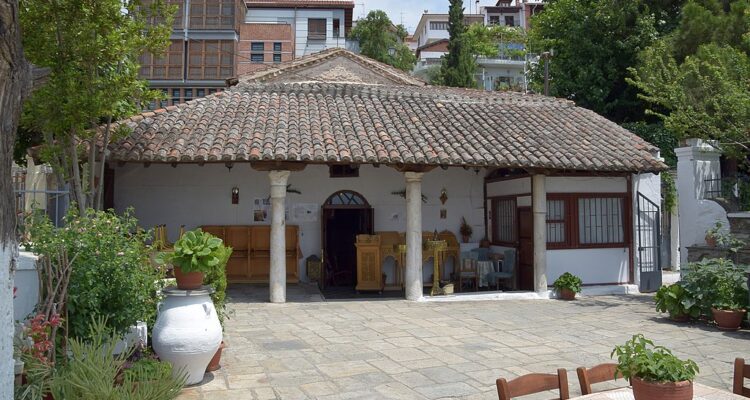The old Katholicon of Latomos Monastery, known today as the Church of Saint David, is an early Christian monument of Thessaloniki. It is located in the Upper Town, at the end of Saint Sophia Street. The temple was originally dedicated to Christ the Saviour, or according to others to the Prophet Zacharias, while the name Saint David was erroneously attributed to it at the beginning of the last century and prevailed since then.
In its original form, the temple was a square building with niches in the eastern side and, within the square, an isosceles cross. The building also had a dome, which was later replaced by a tiled roof. The west side of the building, where the entrance used to be, has been destroyed, and the current entrance is on the south side.
The temple was built on the site of a Roman building at late 5th to early 6th century. At the same time, a mosaic was created in the arch, sponsored by an anonymous woman who, according to tradition, was Theodora, daughter of Emperor Maximian, who had converted to Christianity. In 1430, with the occupation of the city by the Ottomans, the temple was converted into a mosque with the name Sulitze or Keramedin, while another legend says that this conversion happened in the 16th century. In 1921 the temple became Christian again.
The niche mosaic depicts Ezekiel’s vision, with Christ Emmanuel (as a teenager) in the center sitting on the bow of Iris. The 4 rivers of paradise (Phison, Geon, Tigris and Euphrates) flow under his feet. Around him, the symbols of the four Evangelists (a human-angelic face for Matthew, a lion for Mark, an ox for Luke and an eagle for John) are depicted and in the left corner is the prophet Ezekiel standing on the banks of the Hovar River and in the on the right is the prophet Habakkuk or Isaiah. At the same time, the physical element of the scene set in heaven is stated. The depiction of such a theme on the arch is unique in the world.
In the south arch, rich fresco decoration with themes of the Birth and Baptism of Jesus, as well as traces of the Candlemas and the Transfiguration, all artworks of the 12th century, are preserved. Most of the frescoes were designed during the Middle Byzantine period. The frescoes of the Virgin of the Passion, the Entry into Jerusalem, and Christ on the Mount of Olive Trees are probably newer artworks, from the Paleologian period, around 1300. Many of the frescoes are damaged today, due to earthquakes, water leaks, and the plaster used to cover them during the Turkish occupation.
The Temple of Saint David has a simple looking exterior, and was located far from the center of Thessaloniki, near the mountains. This contributed to the theory that Latomou Monastery was not converted into a mosque immediately after the occupation by the Ottomans, as they first converted the best churches in the most central areas. When the temple was converted into a mosque, the walls were covered with plaster. Additionally, during the Turkish occupation, a minaret was added to the southwest corner. Today, only the foundation remains, alongside the spiral staircase.
Copyright 2023 © Created By Diadyktio, All Rights Reserved.
To provide the best experiences, we and our partners use technologies like cookies to store and/or access device information. Consenting to these technologies will allow us and our partners to process personal data such as browsing behavior or unique IDs on this site and show (non-) personalized ads. Not consenting or withdrawing consent, may adversely affect certain features and functions.
Click below to consent to the above or make granular choices. Your choices will be applied to this site only. You can change your settings at any time, including withdrawing your consent, by using the toggles on the Cookie Policy, or by clicking on the manage consent button at the bottom of the screen.

Congratulation!